ROYAL RAJASTHAN: AMBER FORT AND JAIPUR
by Margaret Deefholts
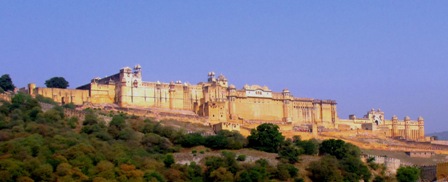
First sight of Amber Fort Palace
The sign at the foot of the Amber fort-palace ramparts, says “Office: Elephant Booking. Amber.” Along with a crowd of slightly nervous, but eager tourists, I buy a ticket, and clamber onto an elephant whose head, trunk and torso is decorated with gaily coloured chalk designs.
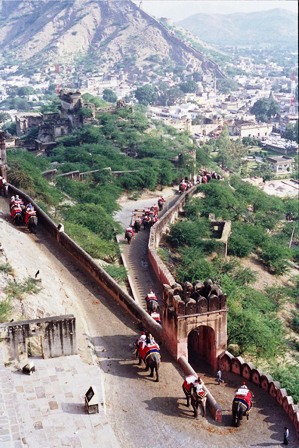
Elephants en route to Amber Palace (photo:Catherine Game)
Author and friend en route to Amber Palace
I hang on to the flimsy howdah railings and hope that my thong-like sandals don't fall off. We start the journey, swaying madly, along a narrow winding road, and for part of the way, my feet dangle over a sheer drop of two hundred feet. I am curling my toes, not only because I don't want to lose my slippers, but also because I'm both exhilarated and terrified! The view (provided I can blank out the precipice looming directly below) is spectacular. The surrounding hills lie against each other like brown camel humps, and a lake in the valley glints in the morning sun.
Ganesh Pol entrance to Amber Palace.
Our amiable pachyderm raises his trunk in a farewell salaam as its passengers descend to terra-firma within the Amber fort entrance courtyard. We walk through the formal gardens of the courtyard (once reserved for royalty), and enter the palace pavilions.
Historic Rajputana ( Land of Kings ) was made up of several clans, the rulers of which claimed descent from the Sun and the Moon. Although these desert kingdoms no longer resound to the clash of swords and battle-cries, the stories and legends still live on in the magnificent palace forts of Rajasthan that rise out of the harsh landscape like defiant fists held up against the sky.
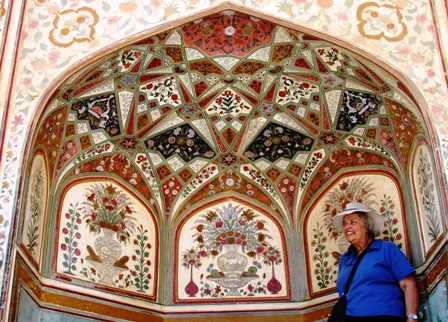
Author in decorated alcove at the Ganesh Pol entrance – Amber Fort Palace
Amber, however, was more palace than fort. It was once owned by the Maharajas of Jaipur, whose ancestors prudently allied themselves with the all powerful Moghuls by giving a Rajput princess in marriage to the Emperor Akbar. Consequently, the towering ramparts of Amber have never been bloodied in war.
In the flat prosaic light of today, the clink of dancing girls' anklets, the sound of women's laughter in the zenana quarters, and the gurgle of wine being poured into gold and ruby-studded goblets, have vanished. Instead, tourists, ordinary citizens and Amber's mild-mannered monkeys now roam across the stone-flagged courtyard fronting the majestic white-pillared Hall of Public Audience.
Yet, for all that, Amber still has evocations of those bygone days of glory, when artists dipped their brushes in powdered gem-stones—lapis lazuli, jade and carnelian— to create a profusion of vivid flower designs on its walls, and master craftsmen carved marble lattice screens. And a time when its palace terraces were cooled by water rippling through aqueducts, and the evening breezes were perfumed with the scent of marigolds and jasmine.
If I were to choose the most spectacular pavilion in Amber, it would probably be the "Shish Mahal" (Hall of Mirrors). Every centimetre of the ceilings and walls is covered in tiny shards of inlaid mirror designs. In olden times, when oil lamps were lit at dusk, the Shish Mahal glittered with pin-points of light, each reflecting off the other like an explosion of stars, reminiscent of the night sky in the deserts of Rajasthan.
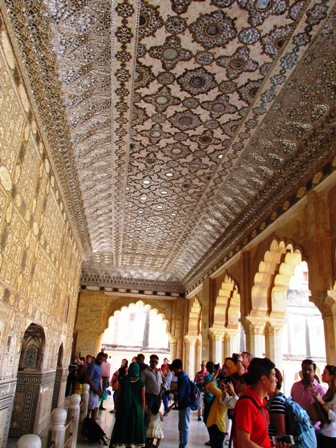 |
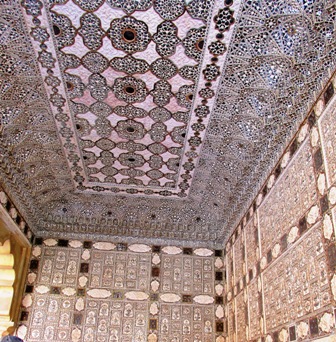 |
Mirror and glass inlay designs cover the ceiling and walls
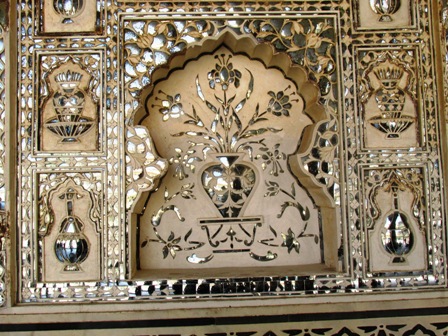
Mirror-work wall decoration in Amber Palace
I join the group on a tourist bus to nearby Jaipur. The city streets are a kaleidoscope of movement and colour. Supercilious camels vie for right of way with horse-drawn tongas , bullock-carts, rickshaws, scooters and cars. Rajasthani women, bedecked with nose-rings and necklaces, wearing mirror-work blouses and skirts, smile as they sway past with earthenware pots balanced on their heads. Men, with enormous yellow or orange turbans and moustaches which erupt off their cheeks, sit in groups smoking hookas or bidis .
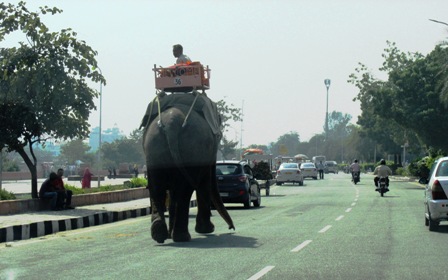
Elephant keeping pace with traffic – Jaipur
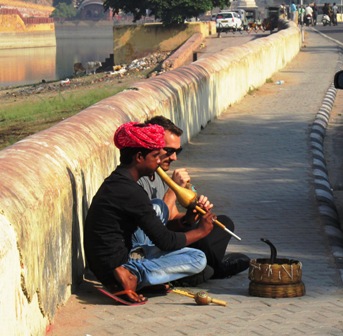
Snake charmer near Amber Fort Palace
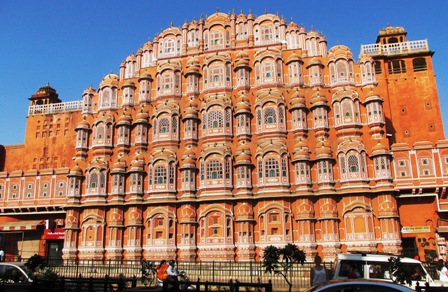
Hawa Mahal – Palace of the Winds, Jaipur
Pink is the traditional colour of Rajasthani hospitality, and as the evening dusk falls around Jaipur, the buildings within the walled " Pink City " turn to the colour of ripe peaches. We pause in front of Jaipur's most photographed landmark, the "Hava Mahal" (Palace of the Winds), with its trellised screens and curved balconies. The Hava Mahal is no more than an elaborately carved facade —one which served an important function: it allowed the royal ladies who observed strict purdah to watch ceremonial processions without being exposed to the gaze of outsiders.
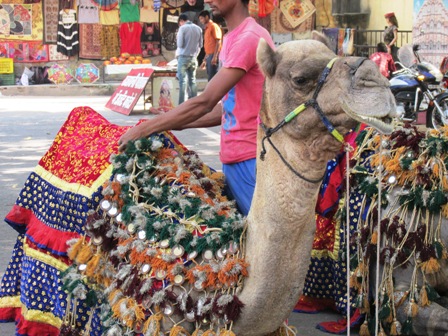
Camel being adorned in festive finery
Ensconced in my hotel room, I glance out of my window and catch sight of a wild peacock dancing in the shade of a flame of the forest tree, fanning his tail and turning from side to side with a slow, courtly grace. Nothing could be a more perfect finale!
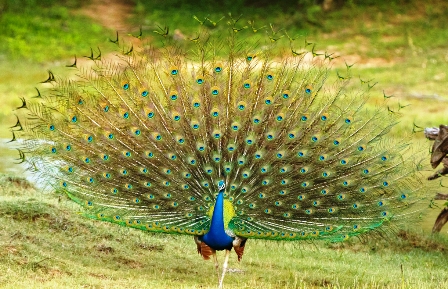
Dancing Peacock (Creative Commons, Wikipedia)
_____________________________________
Travel Writers' Tales is an independent newspaper syndicate that offers professionally written travel articles to newspaper editors and publishers. To check out more, visit www.travelwriterstales.com
IF YOU GO:
Jaipur is conveniently accessible by road and rail from Delhi (approx. 6 hrs) and by air from Delhi and Mumbai, and is serviced by a wide range of hotels.
PHOTOS: by Margaret Deefholts (unless otherwise attributed)